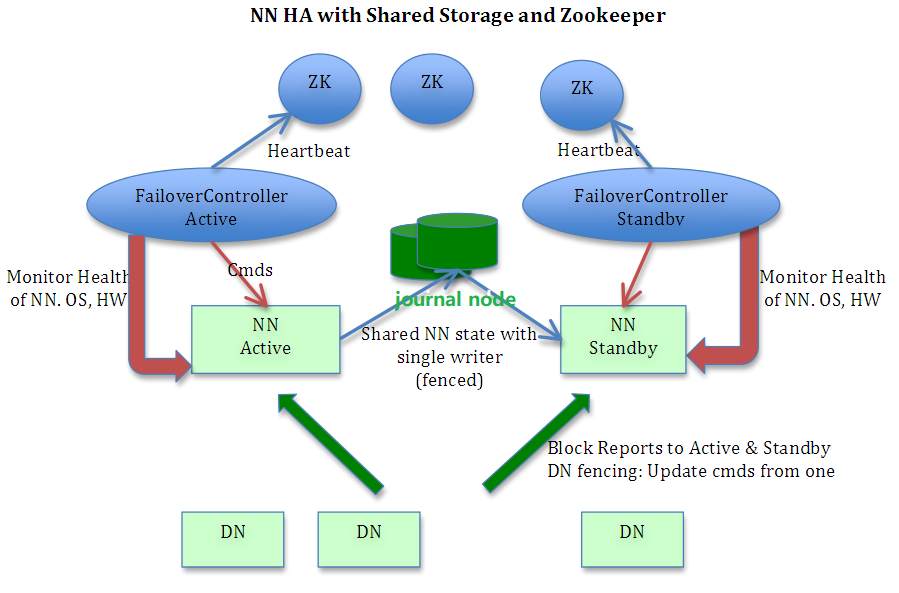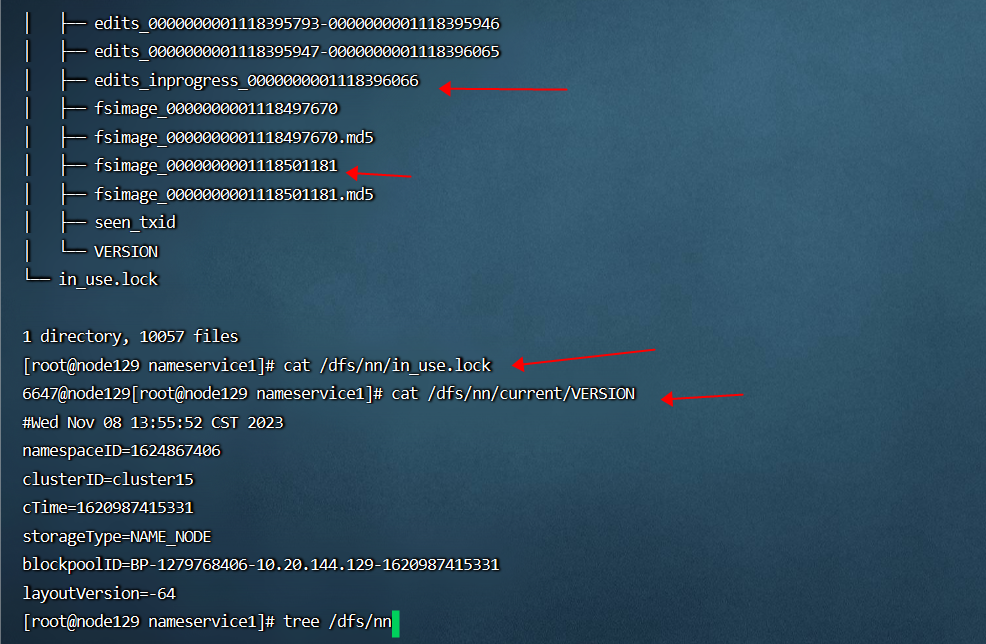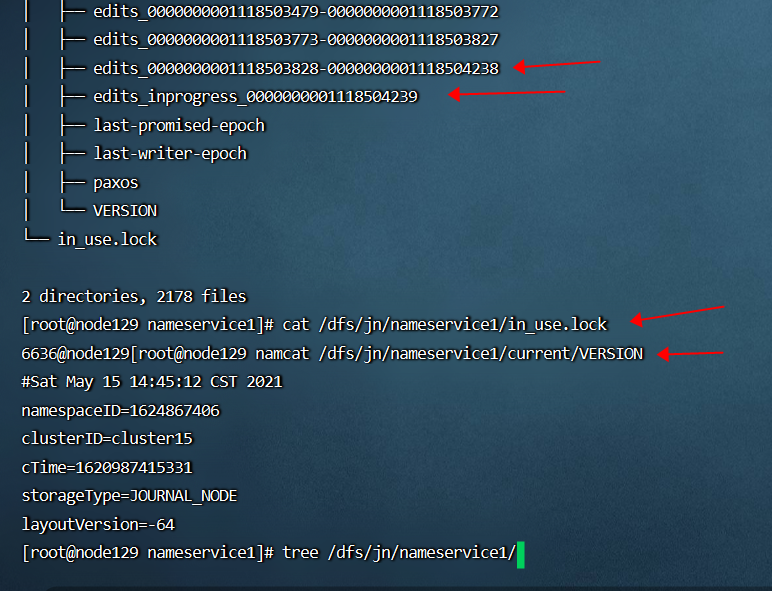盘点下常见 HDFS JournalNode 异常的问题原因和修复方法
盘点下常见 HDFS JournalNode 异常的问题原因和修复方法
最近在多个客户现场以及公司内部环境,都遇到了因为 JournalNode 异常导致 HDFS 服务不可用的问题,在此总结下相关知识。
1 HDFS HA 高可用和 JournalNode 概述
HDFS namenode 有 SPOF 单点故障,因为对客户端提供元数据读写服务的是单一的一个 NameNode,Secondary NameNode 仅仅提供了 HDFS 故障时的可恢复性,而没有提供整个 HDFS 服务的高可用性;
之所以说 Secondary NameNode 仅仅提供了 HDFS 故障时的可恢复性而不是高可用性,是因为 HDFS 发生故障时,Secondary NameNode 并不会自动晋升为 nameNode, 运维管理员需要介入进行手动处理后才能恢复 HDFS 对外服务;
在底层,Secondary NameNode 提供了 fsimage 和 editLog 的合并功能(old fsimage + edit logs = new fsimage),这一过程称为 checkpoint,是基于参数 dfs.namenode.checkpoint.period 和 dfs.namenode.checkpoint.txns,按照时间和事件共同触发的;
为解决 HDFS NAMENODE 的 SPOF,可以配置启用 HDFS 的 HA 高可用,此时其架构如下,可以看到包括 active 与 standby 两个 namenode 互为主备,包括奇数个 zkfc 基于 zk 提供 nn 的故障检测和自动转移,包括奇数个 JournalNode 提供两个 nn 之间共享 editLogs;
Active Namenode 与 StandBy Namenode 为了同步 editLog 状态数据,会通过一组称作 JournalNodes 的独立进程进行相互通信: 当 active 状态的 NameNode 的命名空间有任何修改时,Active Namenode 会向 JournalNodes 中写 editlog 数据, 而 StandBy Namenode 会一直监控 JournalNodes 中 editLog 的变化,并把变化应用于自己的命名空间,从而确保两者命名空间状态的同步和一致,当 Active Namenode 故障出错时,standby Namenode 就可以不丢失数据地实时晋升为 Active Namenode 对外提供服务;
HDFS HA 的详细架构图如下:

HDFS NN 存储元数据信息的本地文件系统目录结构和关键文件如下:

HDFS JN 存储元数据信息的本地文件系统目录结构和关键文件如下:

2 HDFS JournalNode 异常的常见原因
从上述分析可知,HDFS HA 的正常工作依赖于 JournalNode 的正常工作,当集群中半数以上的 JournalNode 节点发生异常后,HDFS HA 就无法正常工作了;
由于 JournalNode 如此重要,绝大部分的大数据集群管理软件如 ClouderaManager/Ambari 等,都会监控 JournalNode 并在其异常时发送告警通知;
如下即是 ClouderaManager 对 JN 同步状态和磁盘空间常见的的监控报警信息:
造成 HDFS JournalNode 异常的常见原因有:
JournalNode 节点的本地磁盘故障或磁盘满,导致写入的 editLog 数据异常;
JournalNode 节点异常并重装了操作系统;
出于扩展集群的需求,新增了 JournalNode 节点;
3 HDFS JournalNode 异常的常规修复方法
HDFS JournalNode 异常,大体应该遵循如下逻辑进行修复:
准备工作:确定当前可以正常工作的 JournalNode 节点,其 editLog 文件的存放位置(即参数 dfs.journalnode.edits.dir 的值),以及当前最新的 editLog 文件 (各个节点各个 editLog 文件的文件名中都包含了递增的 sequence number 序列号,比如历史 editLog 文件 edits_0000000000056586378-0000000000056586407 和 当前 editLog 文件 edits_inprogress_0000000000056586408,序列号最大的即是最新的 editLog 文件);
停止 HDFS 集群;
删除 editLog 脏数据:如果是 JournalNode 节点的本地磁盘故障或磁盘满,则修复/更换磁盘或清理磁盘空间,并删除已经写入的异常的 editLog 文件(也可以删除 dfs.journalnode.edits.dir 目录下的所有子目录和文件,包括 VERSION 文件, edits 文件等;删除前建议先备份);
恢复 editLog 数据:从当前可以正常工作的 JournalNode 节点,拷贝其正常的 editLog 数据文件,可以拷贝 dfs.journalnode.edits.dir 目录下的所有子目录和文件,包括 VERSION 文件, edits 文件等 (事实上只拷贝 VERSION 文件和最新的 editLog 文件也可以,此时后续启动 JournalNode 后,会自动拷贝其它历史 editLog);
确保拷贝过来的所有文件的用户和用户组是 HDFS:chown -R hdfs:hdfs ./*;
启动 HDFS 服务,查看日志,确保恢复正常;
问题 journalnode 节点修复重启后,自动同步和滚动 editLog 的部分日志如下:
4 HDFS JournalNode 异常修复时遇到的常见问题
JournalNotFormattedException:即 Journal 未格式化异常,这种错误经常出现在重装 Journal 节点操作系统时,或添加新 Journal 节点时,修复方法为从其它正常 Journal 节点拷贝 VERSION 文件即可,详细报错如下:
editLog 过期损坏异常:这种错误经常出现在某个 Journal 节点因磁盘异常或其它原因,长期没有跟其它 Journal 节点同步 editLog 数据,导致其最新的 editLog 文件(即 edits_inprogressxxx 文件)过期异常,修复方法为按照上述步骤,删除其异常的 edits_inprogressxxx 文件或全部的 editLog 文件,然后重启 Journal 角色即可(重启后会自动从其它正常 Journal 节点拷贝 editLog 文件),详细报错如下:
/dfs/jn/ns1/in_use.lock 文件锁异常:这种错误经常出现在目录 /dfs/jn 或其子目录和文件的 owner/group 不是 JournalNode 进程的启动用户(一般是 HDFS:HDFS),或者异常启动了多个 JournalNode 进程, 修复方法为更改 /dfs/jn 目录及其子目录和文件的 owner/group 为 JournalNode 进程的启动用户,(chown -R hdfs:hdfs /dfs/jn)并重启 JournalNode 服务进程,详细报错如下:
版权声明: 本文为 InfoQ 作者【明哥的IT随笔】的原创文章。
原文链接:【http://xie.infoq.cn/article/0d8832a2886e3d0be7d2e5446】。
本文遵守【CC-BY 4.0】协议,转载请保留原文出处及本版权声明。








评论